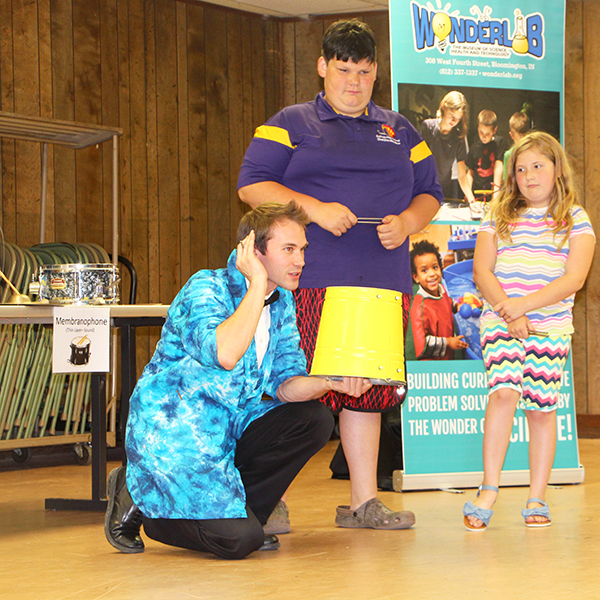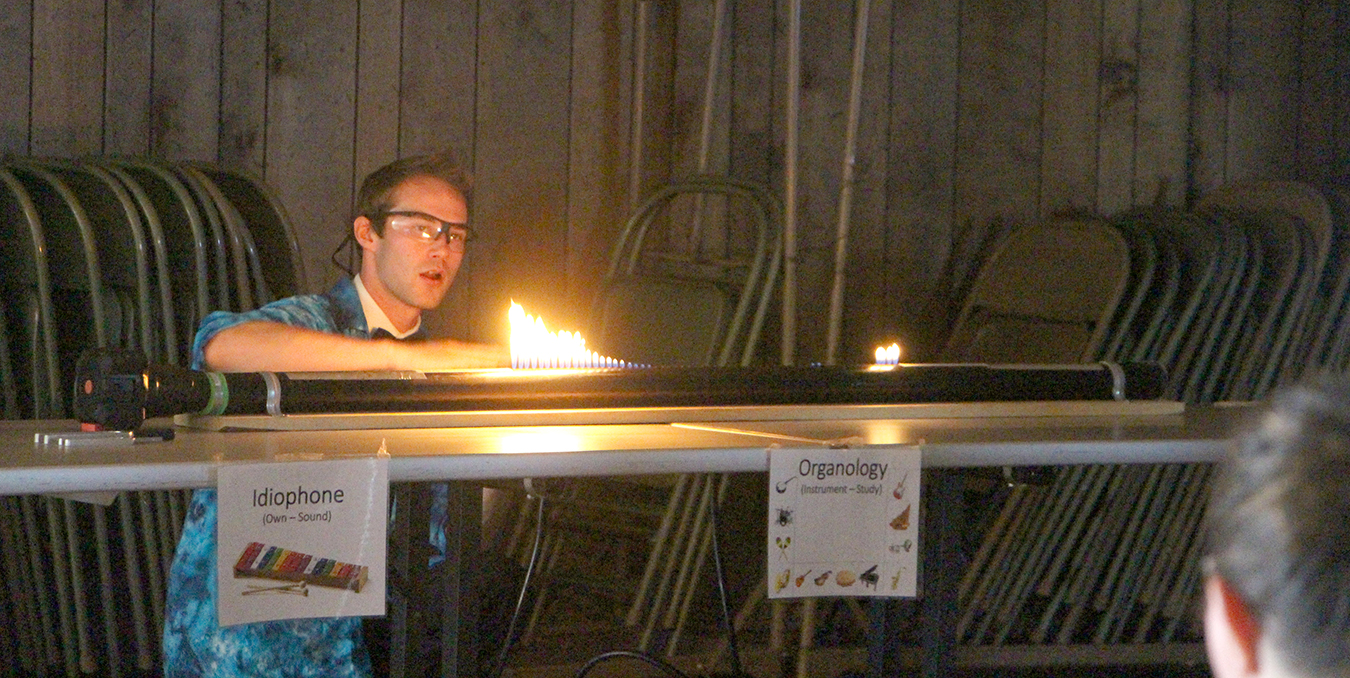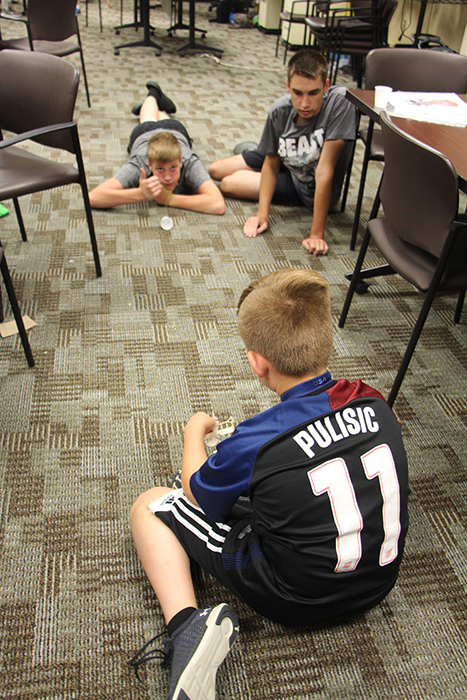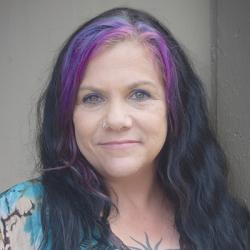
For many students in rural areas of Indiana, STEM learning fades as the school year ends, writes Patti Danner. But a variety of programs are bringing STEM access to rural areas. For example, pictured here is Bloomington’s Wonderlab Museum Educator Nick Whites as he demonstrates sound principles with audience assistants Fred Harvey, left, and Esse Harvey during his June Symphony of Science outreach program in Shelburn. | Photo by Patti Danner
According to the Indiana Afterschool Network, Indiana’s elementary school students receive just two hours per week instruction in science. This means that a student’s excitement about STEM subjects by ninth grade is a better indicator than a letter grade of the child obtaining a STEM career later in life. But for many students in rural areas of Indiana, opportunities for STEM learning fade as the school year ends and they don’t have access to summer activities that fuel that excitement.
However, some organizations — often a county library in collaboration with existing education-based businesses — seek to enrich students during the summer months with various science-based learning opportunities and give access to students who otherwise wouldn’t have it.
The Indiana Afterschool Network also says that, as of June 1, there were 909 out-of-school programs registered in its self-reported directory database.
The travel barrier
WonderLab Museum of Science, Health and Technology offers a plethora of science activities, exhibits, and events at their Bloomington location at 308 W. 4th St., but for children in rural areas, travel to Bloomington can be impossible.
“The travel barrier can prevent a lot of students from the learning opportunities of WonderLab,” says Aleisha Kropf, WonderLab’s marketing and communications director. “So we created Outreach Education. With that, we strive to bring hands-on, interactive STEM learning to as many kids as we can.”
County libraries and other locations in Sullivan, Johnson, Monroe, Owen, Morgan, and Greene counties can bring WonderLab to their locations, solving the transportation problem. Most of these library-sponsored events are free of charge, and others are provided for a modest fee.
One June afternoon in Sullivan County, Wonderlab’s Nick Whites and Grant Chartrand traveled to the Shelburn Public Library to present Symphony of Science to an audience of about 20 students and their parents from the area.
With assistance from members of the audience, Whites demonstrated the science of sound waves, using tuning forks, musical instruments, beakers filled with varying amounts of colored water, and a device called a “Reuben’s tube,” which shows the intensity of sound waves using flames.

Whites demonstrated the physics of sound waves using a “Reuben’s tube” of flames. | Photo by Patti Danner
Shelburn Public Library Director Jordan Orwig says, “We bring this kind of learning to kids in the area as often as we can.” A quick glance at the library’s summer offerings, which includes events called Stuntology and Blindfold Bird Song, back him up.
WonderLab’s other summer event this year is Epic Cold, which offers kids the chance to learn the science of cold and freezing. The museum also offers science learning opportunities through its own YouTube channel, including a weekly science enrichment program designed for toddlers, called Science Sprouts, and Meanwhile … Behind the Scenes at WonderLab, a series of videos that explains how WonderLab exhibits are made.
Clubs and camps
Purdue Extension offices, in collaboration with many of Indiana’s county 4-H programs, offer science learning through SPARK Clubs. These short-term experiences are meant to “spark” interest in new topics and are offered to all students, even those without a 4-H membership, for a $20 enrollment fee.
Once enrolled each year, the number of activities available is unlimited, and students may enroll in clubs such as board- and video-game development, printmaking, knitting and crocheting, and gardening.
“With SPARK Clubs, we offer STEAM learning,” explains Purdue Extension Educator Malea Huffman. “The ‘A’ is added for art and for agriculture learning.” Huffman recently finished a weeklong Game Development SPARK Club in Greene County and says she plans to add other science-related topics to SPARK.
“We have an idea for a mapping technology club,” Huffman says. “Using GIS technology, we would like to map the burial site of every county veteran and offer the information in an interactive way to everyone.”

(Clockwise from upper left) Brayton Yoder, Dominic Wilson, and Brady Taylor created a device that launched a Ping Pong ball into a cup with precision at a Crane STEM Camp in June. | Photo by Patti Danner
Another resource for summer STEM learning is Naval Surface Warfare Center, Crane Division. At Crane’s WestGate Technology Park, Crane STEM Coordinator Tina Closser, winner of the Mira Award for educator of the year, and her staff stay busy with their Summer STEM Camps. In 2017, Crane’s STEM Camps, which were $15 to $25 depending on the camp, served 8,000 students in more than 50 schools, offering hands-on learning with activities, events, competitions, and programs.
“We have broken the camps into grade levels,” Closser says. “Camps are a week long and offer learning in star labs, identifying animal tracks, chemistry, science escape rooms, electronics, and more.”
During one recent camp, offered to kids in grades seven to ten, about 30 students were given some Crane-developed inventions and tasked with repurposing the items for commercial uses.
“We have three items,” Closser says. “The first is a hand grip developed at Crane for weaponry. The students have come up with different uses for the grip that will make it more ergonomic and even more usable for people with disabilities.” Students made slight alterations to the grip that allowed for its use as a paintbrush handle and as a grip for a fishing pole. Another item was a hand-crank generator used to generate power. Students used scientific principles to reduce the number of cranks needed to produce energy from several cranks to just two.
Students Dominic Wilson of Washington and Brady Taylor and Brayton Yoder of Loogootee worked as a team, finishing early in their quest to create a device that would most effectively launch a Ping Pong ball into a plastic cup with precision, using a plastic spoon, wooden sticks, and rubber bands.
Crane also offers a lending library, which allows students and groups to borrow necessary science equipment, free of charge, offsite for a week.
For kids seeking summer learning in the comfort of home, another option to prevent “summer brain drain” is to explore educational apps.
Offered by several developers, STEM-themed apps include Operation Math, a global learning adventure with more than 100 timed math drill “missions”; Toca Lab: Elements, a game featuring all 118 elements from the periodic table; Geography Drive USA, a map trivia game for American geography and history; and Busy Water, a game based on water physics that uses pipes, paddle wheels, and blocks. These apps bring STEM learning to kids anywhere with internet access, preventing the slow erosion of knowledge gained during the school year.
With so many opportunities in Indiana for summer learning, no Hoosier child’s brain should be allowed to drain.

